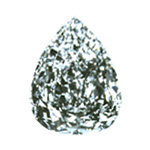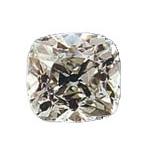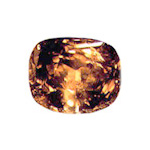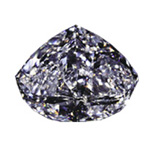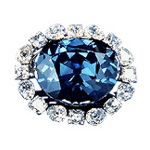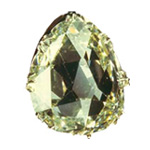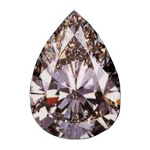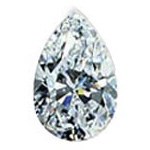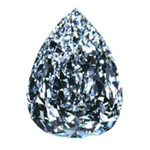Diamonds
Famous Diamonds
The Cullinan
The largest diamond ever discovered was the Cullinan, found in South Africa in 1905. It weighed a massive
3,106.75 carats (uncut) and was the size of an adult man's fist. It was cut into 106 diamonds including
the Cullinan 1 (the Great Star of Africa), a pear shaped stone, pictured at right, presently housed in
the head of the royal scepter in the British crown jewels, and weighing 530.20 carats; the Cullinan II
(the Lesser Star of Africa), a cushion-shaped stone weighing 317.4 carats, and set in the British imperial
state crown; and seven other major stones in the British royal collection. During the Second World War,
the collection was placed in jam jars and buried in a potato field near Windsor Castle, while the crown
jewels were placed in old hat boxes and hidden in a secret passage in the castle. They are all currently
on display at the Tower of London.
The Cullian was cut by Joseph Asscher & Company of Amsterdam, who examined the enormous crystal for around
six months before determining how to divide it.
When the Cullian was first discovered, certain signs suggested that it may have been part of a much larger
crystal, but the "missing half" has never been discovered.
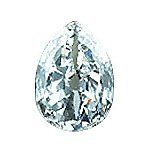
The Excelsior
The Excelsior was also discovered in South Africa and is about one third the size of the Cullinan. It
weighed 995 carats, and was found in 1893 by an African mine worker. The name Excelsior (meaning higher)
came from the stone's unusual original shape - flat on one side and rising to a peak on the other. It was
cut into 21 diamonds, the largest being 69 carats and named the Excelsior 1. Most of the diamonds were
sold to undisclosed parties.
The Regent
Found on the Kistna River, near Golconda, India, by an Indian slave in 1701, this 410-carat stone was
originally known at the Pitt. The diamond was sold to Thomas Pitt who sent it to England to have it cut
and polished. The result - a brilliant cushion shaped diamond of 140.50 carats. In 1717 it was sold to
the Duke of Orleans, regent of France, from which it inherited the name Regent. The royals used the stone
in many ways including setting it in the Crown of Louis XV, using it as a hair ornament for Queen Marie
and as an adornment in the hat of Marie Antoinette. After the French Revolution the stone was set in the
hilt of Napoleon Bonaparte's sword. Napoleon's wife, Marie Louisa, carried the Regent back to Austria
upon his death. Her father later returned it to the French Crown Jewels. Today it remains in the French
Royal Treasury at the Louvre in Paris.
The Golden Jubilee (formerly the Unnamed Brown)
The world`s largest polished diamond, unearthed in 1986, and formerly called the Unnamed Brown is now
known as the Golden Jubilee. The fancy yellow-brown diamond weighs 545 carats and was cut from a 700
carat rough diamond. The stone was designed and cut by Gabi Tolkowsky, who also cut the Centenary
Diamond. The Golden Jubilee was presented to the King of Thailand in 1997 for his Golden Jubilee -
the 50th anniversary of his coronation.
The Centenary
The Centenary diamond was discovered in 1988, and announced on the eve of De Beers one-hundredth anniversary.
The perfectly colored, 599-carat diamond was discovered when De Beers' laser equipment detected a large mass
in one of the walls of its mines.
The irregular shape of the rough stone meant that only the most skilled craftsman would be able to reveal
the diamond's inner beauty without ruining the stone completely.
De Beers commissioned Gabi Tolkowsky, one of the world's most renowned stone cutters. His first decision
had to be where and how to cut. He finally decided that, in spite of its unusual proportions, he would
cut it as one single, large diamond.
One hundred and fifty-four days later, Tolkowsy had removed fifty carats of the magnificent stone. What
remained of the original 'matchbox' stone was a 520-carat diamond. Once the polishing was complete, this
amazing gem weighed 273 carats. While 'The Great Star of Africa' and 'The Lesser Star of Africa' diamonds
actually surpass it in size, the Centenary holds the distinction as the largest modern-cut diamond in
the world.
The Hope Diamond
The Hope is a 45.52 carat blue diamond set as a pendant with 16 white diamonds (pear and cushion cuts)
surrounding it, and a chain of 45 white diamonds.
The stone has an illustrious history and tales abound regarding the ill fortune that befell its owners.
The documented history of the stone, however, began when the French merchant traveller, Jean Baptiste
Tavernier, purchased a 112 carat diamond. This diamond was somewhat triangular in shape and crudely cut.
Its color was described by Tavernier as a "beautiful violet".
Tavernier sold the diamond to King Louis XIV of France in 1668. In 1791, after an attempt by Louis XVI
and Marie Antoinette to flee France, the jewels of the French Royal Treasury were turned over to the
government, but during a week-long looting of the crown jewels in September of 1792, the French Blue
diamond was stolen.
In 1812 a deep blue diamond matching the French Blue's description was documented as being in the
possession of the London diamond merchant, Daniel Eliason. Strong evidence indicates that the stone
was acquired by King George IV of England. At his death, in 1830, the king's debts were so enormous
that the blue diamond was likely sold through private channels.
The first reference to the diamond's next owner is found in the 1839 entry of the gem collection catalog
of the well-known Henry Philip Hope, the man from whom the diamond takes its name. It is not known where
or from whom Hope acquired the diamond or how much he paid for it.
Following the death of Henry Philip Hope in 1839, and after much litigation, the diamond passed to his
nephew Henry Thomas Hope and ultimately to the nephew's grandson Lord Francis Hope. In 1902 Lord Francis
Hope sold the stone to help pay off his debts. It was sold to a London dealer who quickly sold it to
Joseph Frankels & Sons of New York City, who retained the stone in New York until they, in turn, needed
cash. The diamond was next sold to Selim Habib who put it up for auction in Paris in 1909. It did not
sell at the auction but was sold soon after to C.H. Rosenau and then resold to Pierre Cartier that
same year.
In 1910 the Hope diamond was shown to Mrs. Evalyn Walsh McLean, of Washington D.C., at Cartier's while
on her honeymoon in Paris. The diamond was reset and taken to the U.S. where it was later mounted as a
headpiece on a three-tiered circlet of large white diamonds. Sometime later it became the pendant on a
diamond necklace as we know it today. Mrs. McLean's flamboyant ownership of the stone lasted until her
death in 1947.
In 1949, Harry Winston purchased Mrs. McLean's entire jewelry collection, including the Hope diamond,
from her estate.
For the next 10 years the Hope diamond was shown at many exhibits and charitable events worldwide by
Harry Winston Inc. On November 10, 1958, they donated the Hope diamond to the Smithsonian Institution,
and almost immediately the great blue stone became its premier attraction.
The Hope is classified as a type IIb diamond (semiconductive and usually phosphoresce). The Hope diamond
phosphoresces a strong red color, which will last for several seconds after exposure to short wave
ultra-violet light. The diamond's blue coloration is attributed to trace amounts of boron in the stone.
The Sancy
The Sancy is a 55-carat diamond whose origin is believed to have been India. The pale yellow stone
fluoresces yellow and pink, and has become one of the most famous diamonds in history. In 1477 the
diamond was lost on a field of battle by it's first know owner Charles, Duke of Burgundy. Not until
the 16th century was the Sancy Diamond named - for Seigneur de Sancy, a French Ambassador to Turkey.
The Sancy Diamond has been loaned to French Kings Henry III and Henry IV, sold to the English King
James I and traveled to Paris by way of James II. It has been used to raise money for war, lost for
an unpaid loan, bought by a Cardinal, willed to the French Crown and stolen in a great heist of the
French Crown jewels. Later it was a part of the Napoleon court, purchased by a Bombay merchant,
shown at the 1867 Paris Exhibition, and finally made it's way in 1906 to America's Lady Astor
as a wedding tiara.
In 1978, the Astor family sold the Sancy Diamond, returning it to France. It is now housed in the
Louvre in Paris.
The Taylor-Burton
This 69 carat diamond was originally known as the Cartier diamond after Cartier Inc. paid the record
price of $1,050,000 for the gem at auction. The next day Richard Burton bought the stone for Elizabeth
Taylor. It was then renamed the Taylor-Burton diamond. She first wore the pear shaped diamond publicly
at a party for Princess Grace's 40th birthday in Monaco. In 1978, she sold the diamond to build a
hospital in Botswana. The diamond was subsequently purchased by Robert Mouawad.
The Premier Rose
The Premier Rose became one of the worlds largest diamonds when it was discovered in 1978. The diamond
weighed 353.9 carats and was cut into three diamonds known as the Premier Rose family. All of them qualify
to be one of the world's largest diamonds. The largest of the three kept the name Premier Rose and now weighs
137.02 carats, is cut with 189 facets, and is the second largest pear shaped diamond in the world. It was
sold in 1979 for $10,000,000
The Millenium Star
The De Beers Millennium Star is a D-color, internally and externally flawless pear-shape, cut to perfect
proportions, and weighing a hefty 203.04 carats. It is the second largest faceted D-Flawless diamond in
the world, the 273.15 carat Centenary Diamond is the first. The cutting of the Millennium Star set
international precedence in the diamond industry. Only the world's leading diamond cutters were given
the opportunity to work on this stone. The team of cutters, who labored in polishing the collection for
some three years around the clock, was headed by Nir Livnat. The flawless, elongated rough stone was
painstakingly transformed into a classic pear-shaped gem of unbelievable brilliance.
The De Beers Millennium Star is so magnificent that on November 7, 2000 a robbery attempt was made, using
a bulldozer, nail guns and smoke grenades. The would-be robbers plowed towards the exhibit featuring the
Millennium Star, smashing a gate on the way. A boat, moored on the Thames, stood by for the getaway. Once
inside the exhibit, the thieves were foiled by Scotland Yard's Flying Squad, who had been tipped off
previously, and were posing as cleaners. The robbers were arrested without any injuries and were
disappointed to learn that the Millennium Star had been replaced the day before by a replica.
In 2001, De Beers LV purchased the Millennium Star to be the flagship of the new De Beers diamond jewelry
collections. Hidden away for many months since the robbery attempt, the stone reappeared at the Cannes
Film Festival in May 2002. The Millennium Star was set in a stunning necklace of over 200 pave diamonds
worn by style icon Iman at the Cinema Against Aids charity dinner and auction.
